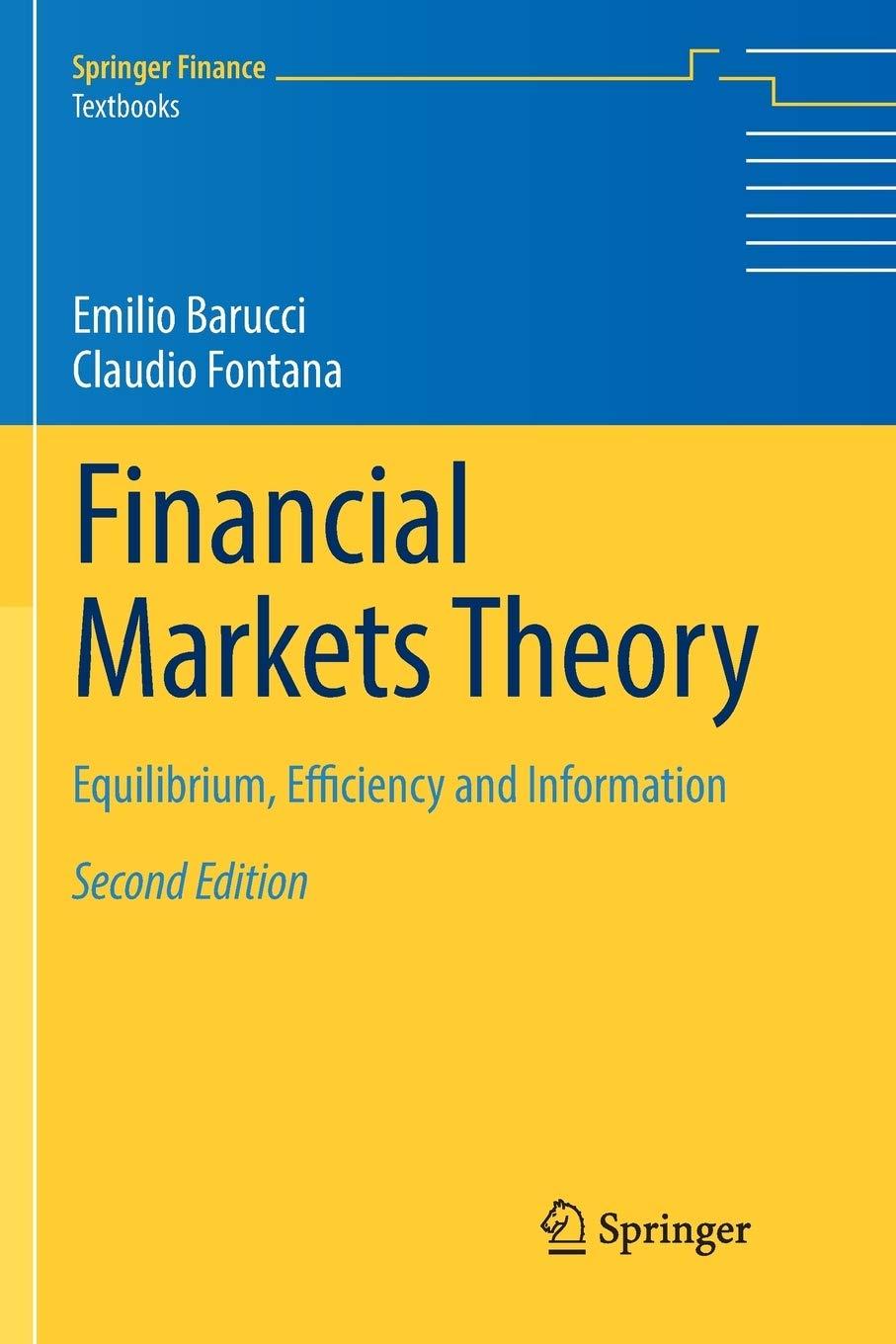Consider the model of Easley & O'Hara [619], where traders are allowed to post market orders of
Question:
Consider the model of Easley \& O'Hara [619], where traders are allowed to post market orders of different sizes, as presented in De Jong \& Rindi [540, Section 4.2]. More specifically, consider the same setting of the simplified Glosten \& Milgrom [790] model presented in Sect. 10.3, characterized by the following assumptions:
- the fundamental value of the asset is represented by the random variable \(\tilde{v}\) which can take the two possible values 1 and 0 with equal probabilities;
- in the economy, there are informed and liquidity traders, with informed traders knowing the exact realization of \(\tilde{v}\);
- there is an exogenous probability \(\alpha\) that an order is being submitted by an informed trader and a probability \(1-\alpha\) that an order is being submitted by a liquidity trader;
- liquidity traders randomly submit buy and sell orders with equal probability;
- informed traders submit buy or sell orders by maximizing their expected profit (i.e., knowing the realization of \(\tilde{v}\), they submit a buy order if \(\tilde{v}=1\) and, on the contrary, a sell order if \(\tilde{v}=0\) ).
Assume furthermore that buy orders can be of two different sizes \(B_{1}\) and \(B_{2}\), with \(0 \[B_{1}=S_{1}=1 \quad \text { and } \quad B_{2}=S_{2}=2\] In this model, the dealer is risk neutral and has the possibility of fixing bid and ask prices for the asset depending on the size of the trade, i.e., the dealer sets \(p^{\text {ask }}(1)\), \(p^{\text {ask }}(2), p^{\text {bid }}(1)\) and \(p^{\text {bid }}(2)\), where \(p^{\text {ask }}(i)\) and \(p^{\text {bid }}(i)\) represent respectively the ask and bid prices for an order of size \(i\), with \(i \in\{1,2\}\). (i) Suppose that informed traders submit large orders with probability \(\mu \in\) \((0,1)\) and small orders with probability \(1-\mu\). By arguing similarly as in Exercise 10.11, show that the equilibrium ask prices \(p^{\text {ask }}(1)\) and \(p^{\text {ask }}(2)\) are given by \(p^{\text {ask }}(1)=\frac{\alpha(1-\mu)+\frac{(1-\alpha)(1-\beta)}{2}}{\alpha(1-\mu)+(1-\alpha)(1-\beta)} \quad\) and \(\quad p^{\text {ask }}(2)=\frac{\alpha \mu+\frac{(1-\alpha) \beta}{2}}{\alpha \mu+(1-\alpha) \beta}\). so that informed traders have incentive to submit only large orders (i.e., in the above notation, it holds that \(\mu=1\) ). Show that in this case the equilibrium ask prices \(p^{\text {ask }}(1)\) and \(p^{\text {ask }}(2)\) are given by \[p^{\text {ask }}(1)=\frac{1}{2} \quad \text { and } \quad p^{\text {ask }}(2)=\frac{(1-\alpha) \beta+\alpha}{2(1-\alpha) \beta+2 \alpha}\]
(ii) Suppose furthermore that the following condition holds:
\[2\left(1-p^{\text {ask }}(2)\right)=1-p^{\text {ask }}(1)\]
meaning that the profit realized by the informed agent when submitting a large buy order coincides with the profit realized by the informed agent when submitting a small buy order (of course, this is a necessary condition for the insider trader to post orders of both sizes). Show that the probability \(\mu\) is then endogenously determined as \[\mu=\beta+\frac{\beta(1-\beta)}{\alpha(1+\beta)}\]
and, as a consequence, the equilibrium ask prices \(p^{\text {ask }}(1)\) and \(p^{\text {ask }}(2)\) are given by \[p^{\text {ask }}(1)=\frac{1-\beta+\alpha(1+\beta)}{2} \quad \text { and } \quad p^{\text {ask }}(2)=\frac{3-\beta+\alpha(1+\beta)}{4} \text {. }\]
The ask prices \(p^{\text {ask }}(1)\) and \(p^{\text {ask }}(2)\) then corresponds to a pooling equilibrium of the economy, where informed traders have incentive to submit both small and large market orders. In this case, the equilibrium bid prices can be computed in an analogous way. In the remaining part of the exercise, we are going to characterize the equilibrium ask prices corresponding to a separating equilibrium of the economy, where informed traders only submit large market orders.
(iii) Suppose that \[2\left(1-p^{\text {ask }}(2)\right) \geq 1-p^{\text {ask }}(1) \text {, }\]
and deduce that a necessary condition for a separating equilibrium to exist is \(\beta \geq \alpha /(1-\alpha)\).
Step by Step Answer:

Financial Markets Theory Equilibrium Efficiency And Information
ISBN: 9781447174042
2nd Edition
Authors: Emilio Barucci, Claudio Fontana





